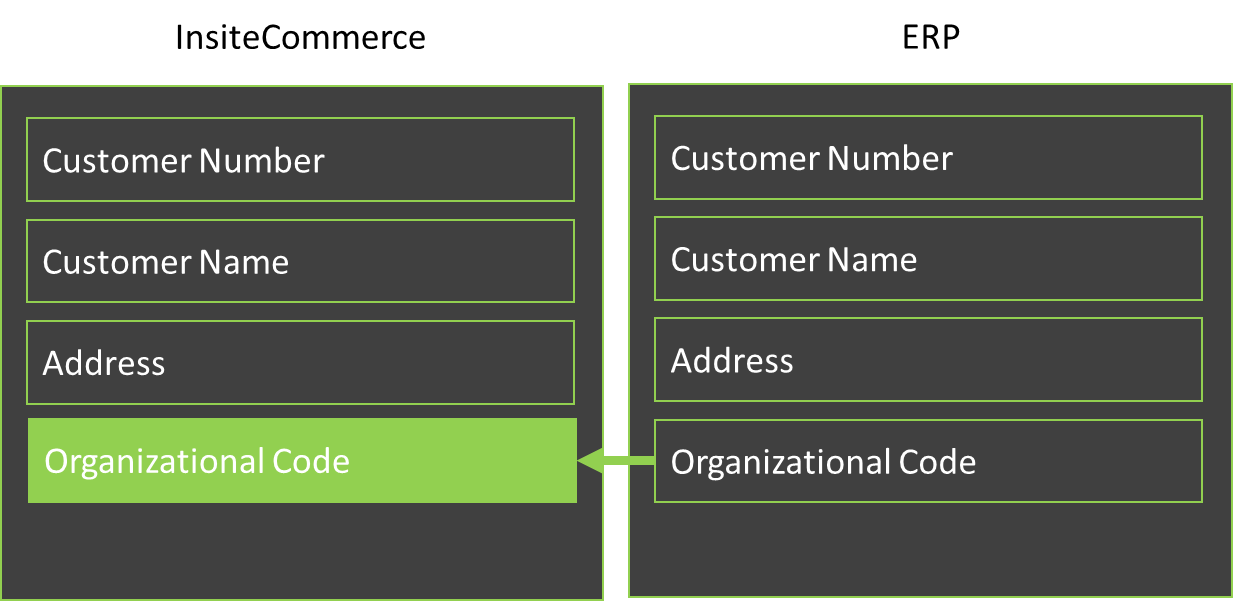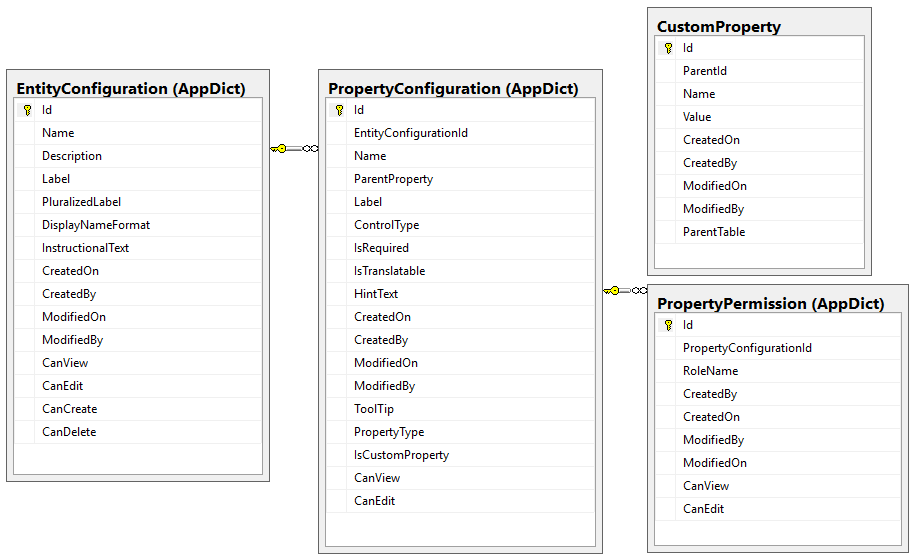Application Dictionary data scheme
Describes the data scheme for the Application Dictionary in the Optimizely Configured Commerce Admin Console.
Entity extension considerations
Optimizely Configured Commerce is designed to accommodate a multitude of business needs. For example, an SAP ERP implementation stores customer data which includes organizational code. Configured Commerce does not include an organizational code on customer records. Therefore, there is a need to extend the Configured Commerce customer entity to map ERP properties to Configured Commerce properties.

Extension options
Configured Commerce has two ways in which to extend the entities within the platform. This can be done one of the following ways:
- Using the Application Dictionary
- Using Configured Commerce .NET objects and methods
Use the Application Dictionary
The entities that define the blueprint of the digital commerce objects needed to operate the platform can be extended using the Admin Console. Additionally, security permissions for fields are also managed from the Application Dictionary. Extending entities within the Admin Console provides a means to enrich the commerce objects with additional data. These fields, or properties, are then populated using any of the following ways:
- Users of the Admin Console
- Developers using Configured Commerce .NET objects and methods
- Configuration of Integration jobs
It is important to note that only basic types such as Boolean and Strings can be stored using application dictionary control types.
Use Configured Commerce .NET objects and methods
Custom properties can also be defined using code. This is usually done within a Handler of the Chain of Responsibility. Defining custom properties in code has the added advantage of storing complex types such as developer defined objects. The limitation here is that those custom properties cannot be edited within the Admin Console.
Implications of using custom properties
From an implementation perspective, custom properties are stored as string values separate from the standard Configured Commerce objects, like Customer and Product. This flexibility in structure lets you store a wide range of content, but can also cause a loss in application performance. Before using a custom property to store data, you should make the following considerations regarding the data and be certain that a custom property is the solution.
- Does the data need to be managed in Configured Commerce? Does it need to be displayed in the Storefront or should the data only be managed in the ERP or PIM? If the data is not required as described above, you should consider not storing it in the platform and keeping it in an external system.
- Does Configured Commerce provide a standard property that can store this data? Each object provides quite a few properties and by default, some of them are not visible in the Admin Console. You can view them by enabling Master Edit Mode from the Debug Tools menu. Once that mode is enabled, you will see more properties displayed on the various detail pages.
- If a standard property cannot be found, can the data be stored on one of the standard properties that is not currently in use? There may be standard properties not currently being used. If you find a standard property with the correct data type, you could store the data in that property. The name of the property won't match the data, but the performance benefits could outweigh the inconsistency.
Custom properties may still be the correct solution. If this is the case and you start to see performance degrading for requests that retrieve those custom properties, you should consider creating a custom endpoint. The endpoint could be used to return only the custom properties you actually need. For example, on the product detail page, you could have a request that retrieves custom properties for that product. This request would be separate from the main product API request that retrieves the product data. If this solution does not work, you could consider creating a custom database table to store the custom properties. The table could be designed specifically for those custom properties, rather than having a table full of string values.
Always consider the need for custom properties. They are a useful and flexible feature, but they can also cause a loss in application performance. Other solutions are available to help offset this loss.
Database schema
The following tables are used for extending the entities and objects within Configured Commerce. Specifically these tables represent the schema used for custom properties and security. These entities are managed using the Application Dictionary.

AppDict.PropertyConfiguration table
Used to store the custom property definition. This custom property record is associated with the AppDict.EntityConfiguration table.
| Column | Data Type | Description | Required |
|---|---|---|---|
| Id | Unique Identifier | The unique identifier. | Yes |
| EntityConfigurationID | Unique Identifier | The unique identifier of the configurations used for entities. | Yes |
| Name | nvarchar(256) | The unique name of the property used in code. | Yes |
| ParentProperty | nvarchar(256) | No | |
| Label | nvarchar(256) | The label used to describe the property. | No |
| ControlType | nvarchar(2048) | The class definition that represents the UI control. | No |
| IsRequired | bit | Identifies if the property is required. | No |
| IsTranslatable | bit | Identifies if the property is included in translation services. | No |
| HintText | nvarchar(2048) | The string used for contextual help. | No |
| CreatedOn | datetimeoffset(7) | The date and time the property was created. | Yes |
| CreatedBy | nvarchar(100) | The username used to create the property. | Yes |
| ModifiedOn | datetimeoffset(7) | The date and time the property was modified. | Yes |
| ModifiedBy | nvarchar(100) | The username used to update the property. | Yes |
| ToolTip | nvarchar(256) | The string used as a description to the property. | No |
| PropertyType | nvarchar(2048) | The underlying data type used to store the property value. | No |
| IsCustomProperty | bit | Identifies if it is a custom property. | Yes |
| CanView | bit | Identifies if the property can be viewed when editing or viewing the entity details. | Yes |
| CanEdit | bit | Identifies if the property can be edited when editing or viewing the entity details. | Yes |
AppDict.EntityConfiguration table
Used to store the entities that can be used and extended within the platform.
| Column | Data Type | Description | Required |
|---|---|---|---|
| Id | Unique Identifier | The unique identifier. | Yes |
| Name | nvarchar(256) | The name of the entity. | Yes |
| Description | nvarchar(2048) | The description of the entity. | No |
| Label | nvarchar(256) | The label used to describe the entity. | No |
| PluralizedLabel | nvarchar(256) | The label used to describe the entity when in a list. | No |
| DisplayNameFormat | nvarchar(1024) | No | |
| InstructionalText | nvarchar(2048) | No | |
| CreatedOn | datetimeoffset(7) | The date and time the property was created. | Yes |
| CreatedBy | nvarchar(100) | The username used to create the property. | Yes |
| ModifiedOn | datetimeoffset(7) | The date and time the property was modified. | Yes |
| ModifiedBy | nvarchar(100) | The username used to update the property. | Yes |
| CanView | bit | Identifies if an object from the entity can be viewed. | Yes |
| CanEdit | bit | Identifies if the entity can be edited. | Yes |
| CanCreate | bit | Identifies if an object from the entity can be created. | Yes |
| CanDelete | bit | Identifies if an object from the entity can be deleted. | Yes |
AppDict.PropertyPermission table
Used to store the permissions related to any custom properties added to the existing entities. By default the following roles are automatically assigned to custom properties (Property Configurations):
- ISC_System
- ISC_Integration
- ISC_Admin
- ISC_ContentAdmin
- ISC_User
- ISC_ContentApprover
- ISC_ContentEditor
| Column | Data Type | Description | Required |
|---|---|---|---|
| Id | Unique Identifier | The unique identifier. | Yes |
| PropertyConfigurationId | Unique Identifier | The unique identifier of the property configuration associated with the entity. | Yes |
| RoleName | nvarchar(256) | The role name allowed to interact with the property. | Yes |
| CreatedOn | datetimeoffset(7) | The date and time the property was created. | Yes |
| CreatedBy | nvarchar(100) | The username used to create the property. | Yes |
| ModifiedOn | datetimeoffset(7) | The date and time the property was modified. | Yes |
| ModifiedBy | nvarchar(100) | The username used to update the property. | Yes |
| CanView | bit | Identifies if the property can be viewed when editing or viewing the entity details. | Yes |
| CanEdit | bit | Identifies if the property can be edited when editing or viewing the entity details. | Yes |
dbo.CustomProperty table
Used to store the values for a given record of an extended entity.
| Column | Data Type | Description | Required |
|---|---|---|---|
| Id | Unique Identifier | The unique identifier. | Yes |
| ParentId | Unique Identifier | Unique Id of the record that has been extended. | Yes |
| Name | nvarchar(100) | The name of the custom property. | Yes |
| Value | nvarchar(max) | The value of the objects custom property. | Yes |
| CreatedOn | datetimeoffset(7) | The date and time the property was created. | Yes |
| CreatedBy | nvarchar(100) | The username used to create the property. | Yes |
| ModifiedOn | datetimeoffset(7) | The date and time the property was modified. | Yes |
| ModifiedBy | nvarchar(100) | The username used to update the property. | Yes |
| ParentTable | nvarchar(100) | SQL table name of the entity that has been extended. | Yes |
Updated 4 months ago